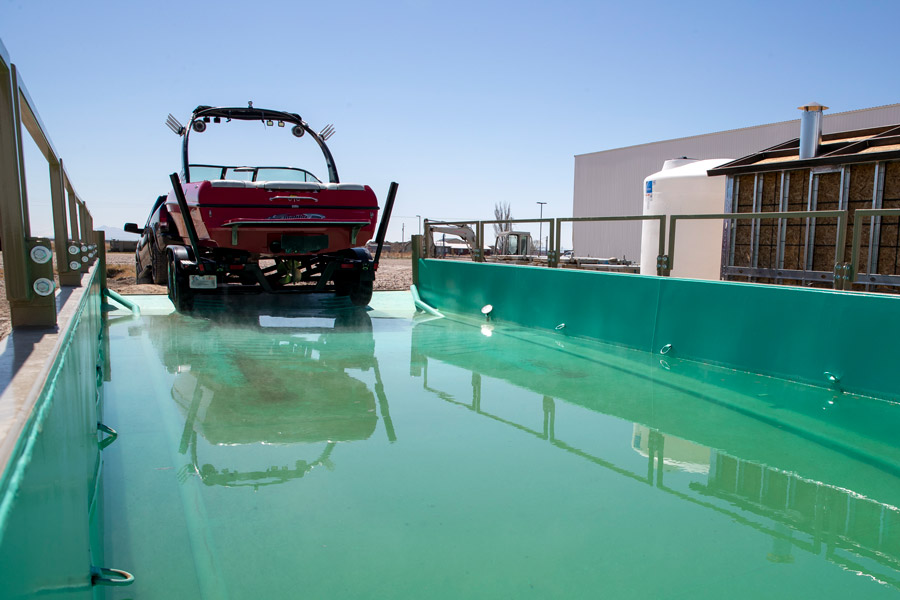DWR and partners announce revolutionary new method for decontaminating boats, removing invasive quagga mussels
Salt Lake City — The Utah Division of Wildlife Resources, Clean Wake LLC, the National Park Service at Glen Canyon National Recreation Area, the U.S. Bureau of Reclamation and other partnering agencies are excited to announce a new first-of-its-kind dip tank method that will revolutionize boat decontamination in the fight against invasive quagga mussels.
The idea for this new decontamination method had been discussed internally within the DWR for nearly a decade, but had remained an abstract concept until almost five years ago when Garrett Atwood — creator of the new patent-pending dip tank and founder of Clean Wake LLC — took a boating trip to Lake Powell.
"I was waiting in the quagga mussel inspection line with other boaters who were trying to leave Lake Powell," Atwood said. "I watched as the DWR staff worked in extreme heat to decontaminate boats of all shapes and sizes, many of which had intake systems that were far from standardized. It seemed like a time-consuming and challenging process, and I thought there had to be a better way."
Atwood began a collaboration with the DWR aquatic invasive species team. After nearly a year of engineering and fabricating, the dip tank was created, complete with a tank, pumphouse, and heating and filtration system. The new tank will be transported from Ogden to Lake Powell, where it will be installed at the Stateline Launch Ramp at Wahweap Marina and will be operational beginning May 1.
Rather than requiring personnel to climb around and under boats to manually spray hot water during inspections and decontaminations, the dip tank allows boaters to back their watercraft into the 14-foot wide, 5-foot deep tank of 110-degree water to more effectively and thoroughly flush complex intake systems. The dip tank includes built-in guiding tracks to help boaters back their watercraft into the tank. The filtration and pump system will turn over the water in the tank every two hours to keep it clean. The whole decontamination will only take about five minutes.
"This new system will be a tremendous asset in our efforts to stop the spread of invasive quagga mussels," DWR Aquatic Invasive Species Coordinator Nate Owens said. "It will involve decontaminating boats with complex systems much faster, will require less training for our staff, will be more effective at ridding complex systems of quagga mussels and will ensure less damage to boats. We are so grateful for the ingenuity of Clean Wake LLC, our partnership with various agencies and the legislative funding and support that have made this possible. This is the first time this method is being used anywhere in the U.S., and we are excited to partner with the National Park Service at Glen Canyon National Recreation Area to create a better experience for boaters at Lake Powell."
While the new dip tank will be utilized beginning this summer at Lake Powell, it will primarily be used for wakeboard boats with complex systems. The standard hot-water spot decontaminations will still be utilized for other boats leaving Lake Powell. The dip tank and standard decontaminations are free to boaters.
Reminders for boaters
Anyone with watercraft — including kayaks, canoes and paddle boards — is required to stop at open aquatic invasive species inspection stations after leaving a waterbody. Anyone who doesn't stop is guilty of a class B misdemeanor.
"We are finding floating mussels and mussel shells that stick to boats as they are retrieved from the water at Lake Powell, so it is absolutely crucial for all boaters to comply with these inspections and to do your part to clean, drain and dry your boat or seek professional decontamination," Bruce Johnson, DWR aquatic invasive species statewide operations lieutenant, said. "If quagga mussels get into water delivery systems in Utah, it will cost millions of dollars annually to remove them and keep the pipes clear, which could result in higher utility bills for every resident."
You must do the following to decontaminate your boat if you choose not to have a professional hot water decontamination done:
- Clean: Boaters must wipe all water, mud, plant materials and other debris from their boats. In particular, make sure to inspect and clean the anchor and empty the sea strainer of all mussel fragments. Sea strainers should remain disconnected until you are ready to launch your boat again.
- Drain: Boaters are required by law to pull all drain plugs and leave them out during transport in Utah. All water should be completely drained from ballast tanks, bilges and live wells. Boaters with outboard or inboard/outboard engines should drop the lower unit to drain those areas, as well.
- Dry: All boats with ballast tanks, inboard engines or inboard/outboard engines retain water at all times, and therefore, will need to meet a 30-day dry time if not professionally decontaminated.
As a reminder, there is a mandatory $20 fee for all motorized boats not registered in Utah that are used anywhere in Utah. In order to pay the fee, owners of boats not registered in Utah will first be required to complete an online education course about preventing the spread of quagga mussels. A link to that online course and the payment portal is available on the STD of the Sea website.

















